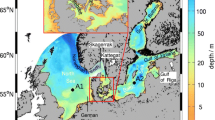Abstract
The influences of horizontal advection and horizontal diffusion on the variability of sea surface salinity in stochastically forced systems are investigated. Basic ideas are developed using a two dimensional box model and then extended to a more realistic three dimensional ocean general circulation model. It is shown that, in the absence of advection and diffusion, the ocean response is essentially that predicted by Taylor's random walk model. Advection becomes important when the advective time scale is less than the response time of the mixed layer to the stochastic forcing. Advection of parcels from regions of upwelling into regions of downwelling limits their exposure time to the stochastic forcing and thus the maximum attainable variance in the system (variance increases linearly with time). Regions of upwelling and downwelling may be introduced through the thermohaline overturning circulation or by the wind driven Ekman transport, depending on the specific model configuration. Horizontal diffusion is found to be important when the diffusive time scale is less than the mixed layer response time. The primary role of diffusion is to reduce the effective stochastic forcing through rapid mixing of uncorrelated surface forcing events. Because sea surface salinity does not have a negative feedback with the atmosphere, it is more strongly influenced by weak horizontal processes than sea surface temperature (SST). Accurate knowledge of the stochastic forcing amplitude, decorrelation time, and length scale and distribution are critical to model the variance of sea surface salinity. Aspects of the ocean model which strongly influence the variability of sea surface salinity include the surface velocity, horizontal diffusivity, and the mixed layer depth. Implications on modeling of the ocean and coupled ocean-atmosphere systems are discussed.
Similar content being viewed by others
References
Birchfield GE (1989) A coupled ocean-atmosphere climate model: temperature versus salinity effects on the thermohaline circulation. Clim Dyn 4:57–71
Broecker WS, Peteet DM, Rind D (1985) Does the ocean-atmosphere have more than one stable mode of operation? Nature 315:21–26
Bryan FO (1986) High latitude salinity effects and intrahemispheric thermohaline circulation. Nature 323:301–304
Bryan K (1969) A numerical method for the study of the circulation of the world ocean. J Comput Phys 4:347–376
Bryan K, Stouffer R (1991) A note on Bjerknes' hypothesis for North Atlantic variability. J Mar Syst 1:229–241
Cox MD (1984) A primitive equation, 3-dimensional model of the ocean. GFDL Ocean Group Tech Rep No. 1
Frankignoul C, Hasselmann K (1977) Stochastic climate models, Part II. Application to sea-surface temperature anomalies and thermocline variability. Tellus 29:289–305
Frankignoul C, Reynolds RW (1982) Testing a dynamical model for mid-latitude sea surface temperature anomalies, J Phys Oceanogr 13:1131–1145
Hasselmann K (1976) Stochastic climate models. Part I. Theory. Tellus 28:473–485
Herterich K, Hasselmann K (1987) Extraction of mixed layer advection velocities, diffusion coefficients, feedback factors, and atmospheric forcing parameters from the statistical analysis of North Pacific SST anomaly fields. J Phys Oceanogr 17:2145–2156
Huang RX, Luyten JR, Stommel HM (1992) Multiple equilibrium states in combined thermal and saline circulation. J Phys Oceanogr 22:231–246
Maier-Reimer E, Mikolajewicz U (1989) Experiments with OGCM on the cause of the Younger Dryas. Ayala-Castanares A, Wooster W, Yanez-Arancibia A (eds) Oceanography 1988. UNAM Press, Mexico DF
Manabe S, Stouffer R (1988) Two stable equilibria of a coupled ocean-atmosphere model. J Clim 1:841–866
Marotzke J (1990) Instabilities and multiple steady states of the thermohaline circulation. PhD Thesis, Ber Institut für Meereskunde, Kiel, June 1990
Mikolajewicz U, Maier-Reimer E (1990) Internal secular variability in an ocean general circulation model. Clim Dyn 4:145–156
Taylor AH, Stephens JA (1980) Seasonal and year-to-year variations in surface salinity at the nine North Atlantic Ocean weather stations. Oceanol Atca 3:421–430
Taylor GI (1921) Diffusion by continuous movements. Proc Lond Math Soc 20:196
Weaver AJ, Marotzke J, Cummins PF, Sarachik ES (1992) Stability and variability of the thermohaline circulation. J Phys Oceanogr (in press)
Weaver AJ, Sarachik ES, Marotzke J (1991) Freshwater flux forcing of decadal/interdecadal oceanic variability. Nature 353:836–838
Author information
Authors and Affiliations
Rights and permissions
About this article
Cite this article
Spall, M.A. Variability of sea surface salinity in stochastically forced systems. Climate Dynamics 8, 151–160 (1993). https://doi.org/10.1007/BF00208094
Received:
Accepted:
Issue Date:
DOI: https://doi.org/10.1007/BF00208094




